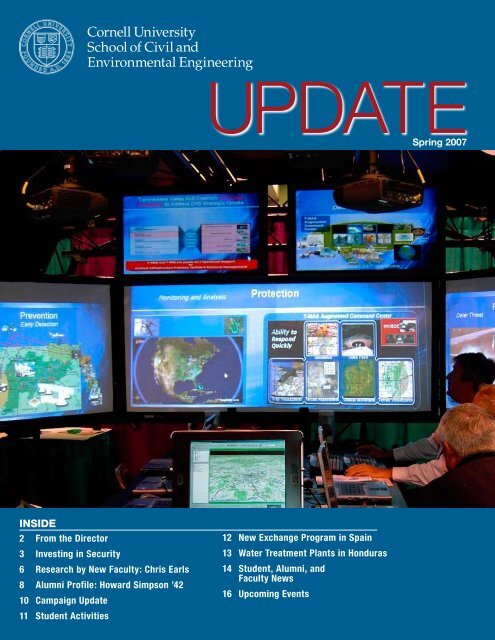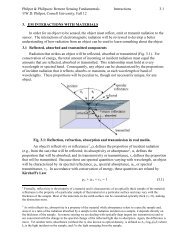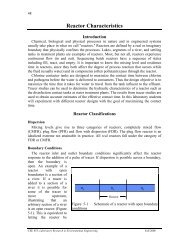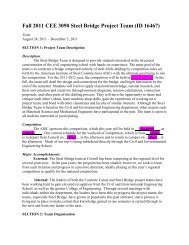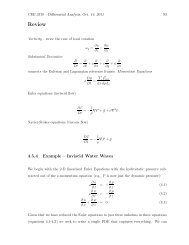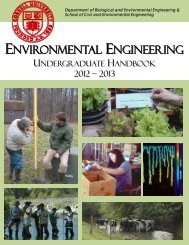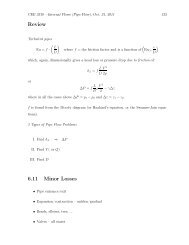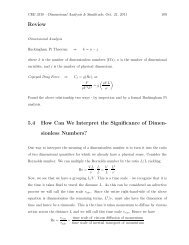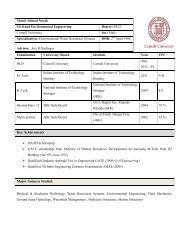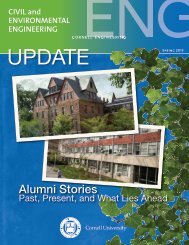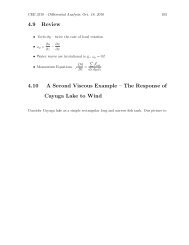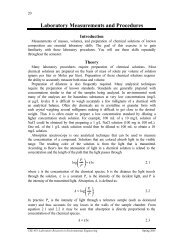Spring 2007 - Civil & Environmental Engineering - Cornell University
Spring 2007 - Civil & Environmental Engineering - Cornell University
Spring 2007 - Civil & Environmental Engineering - Cornell University
Create successful ePaper yourself
Turn your PDF publications into a flip-book with our unique Google optimized e-Paper software.
UPDATE<br />
<strong>Spring</strong> <strong>2007</strong><br />
INSIDE<br />
2 From the Director<br />
3 Investing in Security<br />
6 Research by New Faculty: Chris Earls<br />
8 Alumni Profile: Howard Simpson ’42<br />
10 Campaign Update<br />
11 Student Activities<br />
12 New Exchange Program in Spain<br />
13 Water Treatment Plants in Honduras<br />
14 Student, Alumni, and<br />
Faculty News<br />
16 Upcoming Events
From the<br />
Director<br />
CEE UPDATE is published once<br />
a year by the School of <strong>Civil</strong> and<br />
<strong>Environmental</strong> <strong>Engineering</strong>, <strong>Cornell</strong><br />
<strong>University</strong>, Ithaca, New York.<br />
Director:<br />
James M. Gossett<br />
Director of Administration:<br />
Joe Rowe<br />
Newsletter Production Coordinator:<br />
Jeannette L. Little<br />
Writer:<br />
Roger Segelken<br />
Editor:<br />
Peter R. Hoover<br />
Designer:<br />
Valerie McMillen<br />
Photographs by <strong>Cornell</strong> <strong>University</strong> Photography, FEMA,<br />
Jeannette L. Little, Jennifer W. Morley, and as identified.<br />
Cover photo courtesy of the U.S. Army<br />
Printed on recycled stock.<br />
Produced by<br />
Office of Publications and Marketing at <strong>Cornell</strong> <strong>University</strong>.<br />
<strong>Cornell</strong> <strong>University</strong> is an equal-opportunity, affirmativeaction<br />
educator and employer.<br />
5/07 5.4M CP 070354<br />
<strong>Spring</strong> <strong>2007</strong><br />
James M. Gossett<br />
I’m pleased to present to you this latest edition of Update.<br />
I trust you’ll find it interesting and informative reading. If it has any common<br />
theme, it’s that CEE is becoming more diverse than ever, in terms of the<br />
problems to which we apply our skills. Our field has always been diverse—<br />
spanning (no pun intended!) topics from structural engineering to public<br />
health. But CEE researchers and practitioners are increasingly finding important<br />
roles in less traditional applications such as space exploration, medicine,<br />
nanotechnology, sustainable energy, and the defense against terrorism.<br />
Old-timers will, I am sure, be quick to point out that it has always been so:<br />
For example, Professors Emeriti Bill McGuire and the late Don Belcher were<br />
instrumental in the locating and designing <strong>Cornell</strong>’s Arecibo radio-telescope.<br />
But the scope of our studies has changed since then. CEEs now practice and<br />
research on many levels—from the nano-, to the micro-, to the macro-, to the<br />
mega-scale.<br />
The diversity of CEE is represented by the articles in this edition of Update<br />
that profile the contributions of Professors Linda Nozick and Mark Turnquist<br />
to the global war on terror; and the multiscale research of our newest hire,<br />
Associate Professor Christopher Earls. Chris represents the new breed of CEE<br />
faculty members—he sits with practitioners on professional-society “code”<br />
committees, but also applies his considerable skills in structural analysis to<br />
biomechanics and nano-mechanical devices, in addition to steel structures.<br />
He epitomizes the multiple missions we have at a major research university;<br />
to educate undergraduates and MEng candidates for professional practice,<br />
while also carrying out internationally recognized programs of cutting-edge<br />
research. Diversity of application has also characterized the distinguished<br />
career of alumnus Howard Simpson, profiled in this issue.<br />
We in <strong>Cornell</strong>’s School of <strong>Civil</strong> and <strong>Environmental</strong> <strong>Engineering</strong> have been<br />
heavily engaged in strategic planning for our future. From demographics<br />
alone, we can anticipate a substantial turnover of faculty over the next five to<br />
ten years, and it is imperative that we make strategic decisions about where<br />
to invest our resources. The process began early last fall when we convened<br />
a workshop on campus to discuss “The Future of CEE.” Nearly all of our faculty<br />
members participated, along with nearly all the members of our external<br />
Advisory Council, plus some special guests. It was an invigorating exercise,<br />
as we tried to identify the great challenges that will face society over the next<br />
30 to 50 years, and our profession’s potential role in addressing them. Among<br />
the weighty questions we are considering is this: In a present (and likely future)<br />
where CEEs apply their skills to problems beyond our traditional realm<br />
of “public works,” what defines CEE and distinguishes it from other fields of<br />
engineering?<br />
We’d love to hear from you. In the meantime, enjoy this issue of Update!
Inve$ting in Security:<br />
CEE Researchers Linda Nozick and Mark Turnquist Take<br />
Decision-Making “Games” to the Next Level<br />
In a time of heightened security at airports—and frequent<br />
delays when would-be passengers stare out the windows<br />
at departure gates and wonder, “What are all those people<br />
fussing around the airplanes really doing there?”—Linda<br />
Nozick gets paid to think the thoughts most passengers<br />
dare not verbalize: “What’s the chance, for example, of a<br />
bad guy with a fake ID getting on the tarmac and sneaking<br />
a bomb aboard my airplane?”<br />
Nozick, a professor of civil and environmental engineering<br />
and a specialist in network analysis for transportation<br />
systems, gets paid to think about terrorists, airplanes, and<br />
bombs because such scenarios are in the national interest.<br />
She reports her conclusions, together with those of colleagues<br />
at <strong>Cornell</strong> and at Sandia National Laboratories, to<br />
the federal Department of Homeland Security in reports with<br />
titles like “Physical Security and Vulnerability Modeling for<br />
Infrastructure Facilities.”<br />
The so-called “intruder models” that Nozick develops—<br />
and then analyzes with a mathematical framework called<br />
Markov modeling—are much more specific than the titles of<br />
her official reports might suggest. Here’s one, for instance:<br />
Suppose that an intruder carrying an explosive device<br />
knows that three areas of vulnerability—for an aircraft being<br />
serviced on the apron—are the open doors of the cargo hold,<br />
the landing gear that will fold into the wings, and the catering supplies<br />
for the airplane’s galley.<br />
Then suppose that the intruder’s stolen ID badge indicates that<br />
he or she works for a catering company. That badge and impersonation<br />
might get the intruder through security and onto the apron.<br />
But a purported caterer hanging around the landing gear would<br />
attract attention. Luckily (for the intruder), he or she thought to bring<br />
a second badge and other trappings of an aircraft mechanic. Or<br />
Professor Linda Nozick<br />
the identity of a baggage handler, if a bomb in<br />
the cargo hold is part of “Plan B.”<br />
Even if the intruder succeeds in placing a<br />
bomb, he or she must get away without being<br />
detected. Otherwise, the aircraft will be thoroughly<br />
searched and the attempted attack will<br />
be foiled.<br />
What are the chances the intruder will reach<br />
the apron in the first place? Will the intruder get<br />
the opportunity to place the bomb . . . and exit,<br />
undetected?<br />
istockphoto.com, carole gomez<br />
Once the results of Nozick’s modeling exercises reach the<br />
right people in Homeland Security, policy-makers will have<br />
the information to know where to invest in improved security<br />
and reduced vulnerability.<br />
Such is the power of Nozick’s approach to transportation<br />
security: to combine network representations of<br />
systems—in this case, the security provisions around passenger<br />
planes—with Markov models of intruders’ strategies<br />
and actions. “We start the model running by assuming the<br />
worst about our intruders, that they are both rational and<br />
well informed,” Nozick explains. By rational, she means that<br />
the adversaries follow a strategy to maximize the probability<br />
that their attack will be successful. And well-informed adversaries<br />
know the probability of succeeding in the plan (and<br />
of not being detected) at every step, so they can effectively<br />
optimize their attacks.<br />
“We need to assume the adversary is better than he<br />
or she might actually be, because that assumption gives
Investing in Security . . . (continued from page 3)<br />
our calculations an ‘upper bound’ on<br />
probability of success. We want to be<br />
conservative in estimating how wellprotected<br />
the system should be. While<br />
we recognize that a less-able adversary<br />
can sometimes get lucky, by assuming<br />
the worst we can make sure the probabilities<br />
of their success are as small<br />
as possible.”<br />
Nozick believes Markov modeling<br />
(and a refinement called “hidden<br />
Markov modeling,” or HMM) are<br />
useful tools for analyzing decisionmaking<br />
of adversaries in transportation<br />
security applications. HMM<br />
works well in situations for which<br />
outcomes are partly random (an<br />
actual mechanic might see a purported caterer meddling<br />
with the landing gear) and partly under the control of the decision maker (the<br />
intruder thought to bring a second fake ID badge).<br />
And the approach she’s testing with aircraft security, Nozick believes,<br />
should work equally well for most of the other 12 sectors of American society<br />
in which the Homeland Security Office perceives vulnerability to “intruders”:<br />
agriculture, food processing, water, public health, government, emergency<br />
services, banking and finance, telecommunications, energy, the chemical industry,<br />
postal and shipping services, and the defense-related industrial base.<br />
While an intruder to the banking sector might wield a self-replicating computer<br />
virus—instead of a bomb in a box of airline pretzel snacks—the process<br />
is similar: Compute the probability of a successful attack, model possible strategies<br />
to reduce vulnerability, and advise policy makers on optimal investments<br />
to improve security.<br />
In fact—because virtually all parts of modern society’s infrastructure (from<br />
the electric power grid to government administration) rely on information<br />
technology and the Internet—a well-placed virus could be just as disruptive<br />
as a bomb, observes Mark Turnquist, another CEE professor who works on<br />
transportation-security problems. Having said that, Turnquist explains his particular<br />
piece of the security-analysis task. It is a problem that will seem relevant<br />
to anyone who ever is puzzled over those hazardous-materials icons on the<br />
sides of semi-trailer trucks.<br />
Again, this is one of those unthinkable thoughts, albeit one that passengers<br />
in private automobiles can verbalize without attracting attention:<br />
What’s to keep a terrorist from learning the route and schedule of that chlorine<br />
tanker, then planting a bomb when it goes through a populated area like,<br />
for instance, my town?<br />
Chlorine is far from the nastiest substance that Turnquist ponders when he<br />
does his transportation-security and vulnerability-reduction modeling. But<br />
a cloud of chlorine gas from a ruptured container, spreading at ground<br />
level and attacking human lungs, is a realistic example—considering<br />
that thousands of big chlorine tankers are crisscrossing<br />
America at any given time.<br />
“At one time, a shipper of chlorine used to choose one<br />
route—usually the cheapest and fastest,” Turnquist notes.<br />
“A single, predictable route made sense, in terms of keeping<br />
the customers satisfied, when cheap was all that mattered.<br />
We have had mathematical models to help shippers<br />
choose cheap routes for a long time.”<br />
But the threat of terrorism adds another level of complexity<br />
to the problem, according to Turnquist. “An adversary<br />
can know where your trucks will be if you use a single,<br />
predictable route and schedule. Transportation security<br />
would be better if the shipper used game theory—to make<br />
it less likely that an adversary will be successful.” A shipper’s<br />
strategy might change, based on the Department of<br />
Homeland Security Threat Advisory Level, for example.<br />
Like Nozick’s modeling of aircraft security, results of<br />
Turnquist’s work on hazardous-materials transportation<br />
goes through Sandia National Laboratories and on to<br />
Homeland Security.<br />
That all-encompassing agency, which came under<br />
public scrutiny in the less-than-optimal federal response to<br />
Hurricane Katrina, could also benefit from another version<br />
of <strong>Cornell</strong>’s vulnerability-reduction modeling—determining<br />
where to pre-position emergency relief supplies for natural<br />
disasters before they strike.<br />
Again, predictability and probability are parts of the<br />
equation, Turnquist observes: “If you pre-position your<br />
medical kits, prepackaged food, water, and ice in the<br />
exact location where the storm strikes, you could lose<br />
everything. But if you pre-position too far away, you could<br />
<br />
Professor Mark Turnquist
have trouble transporting supplies to where the need is<br />
greatest.”<br />
Turnquist and Nozick’s work is actually performed for<br />
the National Infrastructure Simulation and Analysis Center<br />
(NISAC), which is jointly operated by Sandia and Los<br />
Alamos national laboratories. The mission of NISAC is to<br />
provide analytic support and modeling capabilities to the<br />
Department of Homeland Security for a broad spectrum<br />
of infrastructures, from electric power, banking, and food<br />
to transportation. NISAC subcontracts some projects<br />
to nongovernmental labs with special expertise, which<br />
in the case of <strong>Cornell</strong> is transportation security. CEE<br />
PhD students Yashoda Dadkar and Carmen Rawls are<br />
important participants in this research.<br />
Because of the classified nature of<br />
national security, some details of Turnquist<br />
(left to right) Yashoda Dadkar and Carmen Rawls<br />
and Nozick’s work are not “publishable”<br />
in the general scientific literature. But a<br />
surprising amount is, and that’s a good<br />
thing, according to Turnquist. “The<br />
core question—if we are going to invest<br />
resources to change operations and<br />
make systems less vulnerable—is this:<br />
‘Where should we invest and what should<br />
we do?’”<br />
“Core questions about strategic investment are vitally important to national<br />
security,” Nozick adds, “and we hope the tools we develop will be useful to the<br />
nation. But every enterprise, whether public or private, has vulnerability and<br />
investment issues. We think our tools are too valuable and too broadly relevant<br />
not to share.”<br />
Research insights by Nozick and Turnquist show up almost immediately<br />
in <strong>Cornell</strong> classrooms—minus sensitive national-security details, of<br />
course—in classes like CEE 593: <strong>Engineering</strong> Management Methods:<br />
Data, Information, and Modeling, which is taught by Turnquist. Nozick’s<br />
newly developed course, CEE 406/606: <strong>Civil</strong> Infrastructure Systems,<br />
teaches systems-engineering tools such as optimization, life-cycle cost<br />
analysis, decision analysis, simulation, Markov modeling, and risk analysis.<br />
<strong>Cornell</strong> students learn to do modeling for all kinds of systems—not just<br />
the ones of interest to Homeland Security—and they get a bonus: Some<br />
new “games” to play while waiting to board flights to the next job interview.<br />
—Roger Segelken
New<br />
Faculty Profile:Chris Earls<br />
Answers the<br />
“What if?”<br />
Questions<br />
Riding along on family trips to Brooklyn from<br />
his boyhood home in Washington, D.C., young<br />
Chris Earls crossed some interesting bridges.<br />
Maryland offered the Francis Scott Key (a<br />
continuous truss bridge over the Patapsco<br />
River) and the Millard E. Tydings Memorial (over<br />
the Susquehanna, with its ominous warnings<br />
on dangerous crosswinds). Then it was the<br />
Delaware Memorial (another suspension bridge,<br />
across the Delaware river to the New Jersey<br />
Turnpike), the Goethals Bridge (named for the<br />
Panama Canal engineer, and crossing the<br />
murky Arthur Kill to Staten Island), and finally the<br />
Verrazano Narrows (once the longest suspension<br />
bridge in the world). A special treat was a<br />
stroll across the wood-planked pedestrian walkway<br />
of the Brooklyn Bridge, which was near<br />
Earls’s grandparents’ home.<br />
As the sheer joy—of vaulting wide, high<br />
spaces with man-made creations of concrete<br />
and steel—matured to curiosity, he wondered:<br />
Why are bridge designs so different? Which is<br />
better? And for what purpose? Inevitably, the<br />
questions became the “What if?” kind: Suppose<br />
a tugboat hauling barges hit the bridge? What<br />
if some of the cable strands rusted away? How<br />
many heavy trucks would be too many? Or how<br />
much wind could the bridge withstand?<br />
Kids in cars tend to ask those questions. So<br />
do structural engineers.<br />
Still, the boy who would become the newly<br />
appointed associate professor of structural engineering,<br />
Christopher J. Earls, didn’t go directly<br />
U.S.S. Cole being transported aboard the MV Blue Marlin semi-submersible<br />
heavy-lift ship<br />
there. He started college with astrophysics in<br />
mind, and greatly admired Carl Sagan. But<br />
partway through Virginia Polytechnic Institute<br />
and State <strong>University</strong>, Earls figured that some<br />
of the same mathematics and physics that<br />
Sagan (1934–1996) was using to fathom the<br />
cosmos might also help build better structures<br />
on this planet. After a 1990 bachelor’s and<br />
1992 master’s degree in civil engineering at VPI,<br />
Earls completed a PhD in structural engineering<br />
at <strong>University</strong> of Minnesota (1995). Moving to<br />
West Point, he won the United States Military<br />
Academy’s 1998 Outstanding Teacher Award.<br />
At <strong>University</strong> of Pittsburgh, where Earls rose to<br />
become chairman of the Department of <strong>Civil</strong><br />
and <strong>Environmental</strong> <strong>Engineering</strong>, he was given<br />
the 2001 Outstanding Professor of the Year<br />
Award by the Pittsburgh section of the American<br />
Society of <strong>Civil</strong> Engineers.<br />
Earls’s knack for teaching caught the attention<br />
of <strong>Cornell</strong>’s School of <strong>Civil</strong> and <strong>Environmental</strong><br />
<strong>Engineering</strong>, which hired him in 2006.<br />
Here he teaches CEE 474: Design of Steel<br />
Structures and CEE 779: Advanced Behavior<br />
of Metal Structures. Earls also is the faculty<br />
leader for the MEng (two-semester professional<br />
master’s degree) in structural engineering,<br />
where a recent project involved designing a<br />
new bridge to take Interstate 74 across the<br />
Mississippi River.
Earls’s students came up with a single cable–<br />
stayed bridge that addresses a civil-engineering<br />
challenge: to bring a bottleneck (the existing<br />
Iowa–Illinois Memorial Bridge on I-74 that aggravates<br />
65,000 late-for-work drivers a day) up to<br />
current Interstate standards—with what will be<br />
the widest bridge in the world.<br />
In addition to multiple lanes for vehicular traffic,<br />
the next I-74 bridge will feature a pedestrian crossing<br />
between Moline, Illinois and Bettendorf, Iowa.<br />
And a pedestrian lane on a bridge these days, the<br />
MEng students learned, must be wide and strong<br />
enough to accommodate not only walkers, runners,<br />
and bicyclists but a truck-size ambulance,<br />
as well. When engineers at the firm with the government<br />
contract for the new I-74 bridge saw the<br />
<strong>Cornell</strong> students’ design, they praised the innovative<br />
solutions to some difficult problems.<br />
Earls’s knowledge<br />
of steel structures<br />
of buildings like<br />
the World Trade<br />
Center towers<br />
made him a book<br />
reviewer . . .<br />
Earls’s own research in computational mechanics<br />
stretches from the large and real to the<br />
infinitesimally small and hypothetical. In one project<br />
sponsored by the Office of Naval Research,<br />
he is trying to determine if in situ instrumentation<br />
throughout a ship’s structure could inform the<br />
captain of the vessel’s structural integrity. That<br />
kind of instrumentation would have been helpful,<br />
according to Earls, when terrorists approached<br />
the U.S.S. Cole in a small boat in the Yemeni<br />
port of Aden on October 12, 2000, and killed 17<br />
American sailors by blasting a 35- by 36-foot<br />
hole in the guided missile destroyer’s port side.<br />
Instead of sending divers to perform a prolonged<br />
(and qualitative) inspection of the ship’s<br />
hull, a skipper under orders to leave the port<br />
immediately could monitor the damage with the<br />
instrument array and compute the likelihood that<br />
the vessel could move out of harm’s way without<br />
sinking.<br />
Eleven orders of magnitude smaller than a<br />
naval warship, in the 250-nanometer range,<br />
are the electromechanical oscillators that<br />
biosecurity policy-makers hope someday soon<br />
will measure masses of airborne pathogens,<br />
such as viruses, with attogram sensitivity—and<br />
differentiate one kind of virus from another.<br />
An attogram is one-thousandth of femtogram,<br />
Terrestrial laser scanner–derived image of a damaged<br />
bridge<br />
which is one-thousandth of a picogram,<br />
which is one-thousandth of a nanogram,<br />
which is one-billionth of a gram. Across the<br />
<strong>Engineering</strong> Quad from Earls’s Hollister Hall<br />
office, nanobiotechnology researchers in<br />
Duffield Hall are fabricating oscillating cantilevers<br />
for devices that can tell the difference<br />
between 6 attograms and 60. Earls wants to<br />
determine the dynamic stability of the oscillating<br />
cantilevers—and whether the same<br />
laws of physics apply to structures at the<br />
scales of the atom, the I-74 bridge, and the<br />
cosmos.<br />
Dynamic instability is one of the factors that<br />
determine whether bad things happen to good<br />
structures, or so the youthful bridge-crosser<br />
who became a nationally recognized expert<br />
on structural integrity came to understand.<br />
For example, when attachment bolts failed<br />
and dropped a 12-ton ceiling panel on a car<br />
in Boston’s “Big Dig” tunnel last year, the NPR<br />
radio show, “Science Friday,” and host Ira<br />
Flatow asked Earls to explain, and to answer<br />
“What if?” questions from concerned callers to<br />
the popular show.<br />
When the publishers of Popular Mechanics<br />
magazine debuted the book, Debunking 9/11<br />
Myths: Why Conspiracy Theories Can’t Stand<br />
Up to Facts, Earls’s knowledge of steel structures<br />
of buildings like the World Trade Center<br />
towers made him a book reviewer, among other<br />
nationally known experts. In retrospect, he<br />
thinks that only buildings fortified to the standards<br />
of nuclear-plant containment vessels can<br />
Damaged bridge<br />
withstand a hit from a fully fueled airliner flying at<br />
full throttle. The best defense against 9/11–type<br />
strikes, he says, is to keep big planes away<br />
from tall buildings.<br />
While Earls claims no mystical powers of<br />
prescience—when it comes to terrorists, airplanes,<br />
and towering structures—he came<br />
eerily close on September 5, 2000. That is the<br />
date on a structural-engineering analysis exercise<br />
he handed to his students at <strong>University</strong> of<br />
Pittsburgh, a year and six days before 9/11. The<br />
hand-drawn diagram on the exercise shows a<br />
plane the size of a 747 hitting the top of a 100-<br />
story building.<br />
It was another one of those “What if?” questions.<br />
Would the building fall? The uncomplicated<br />
answer that Earls hoped Pitt students would<br />
come up with is this: A building that is properly<br />
designed to withstand sustained high winds<br />
should not fail from the impact of an airplane.<br />
But devastating fire that results from the ignition<br />
of the thousands of gallons of fuel contained<br />
in a speeding plane is another matter, he notes.<br />
Ever since a B-25 bomber blundered through<br />
fog into the 79th floor of the Empire State Building<br />
in 1945, structural engineers have assumed<br />
that accidental strikes would come from relatively<br />
slow-moving planes. And they have designed<br />
for that kind of scenario, Earls explains, as he<br />
returns the loose-leaf binder of exercises to his<br />
office bookshelf.<br />
Courtesy of Bob Dexter, Univ. of Minnesota<br />
—Roger Segelken
ALUMNI PROFILE<br />
Howard Simpson BCE ’42:<br />
Expanding the Horizons of Structural <strong>Engineering</strong><br />
Swing-wing fighter-bombers and moon rockets, acts of terrorism and atom<br />
smashers, radio telescopes and the Statue of Liberty: When Howard Simpson<br />
says he had “no idea, no concept of the variety of areas that the civil engineering<br />
discipline could become involved in” when he graduated with a bachelor’s degree<br />
in civil engineering in 1942, don’t blame him for a lack of vision . . . or the faculty of<br />
the old School of <strong>Civil</strong> <strong>Engineering</strong> for a lack of preparation.<br />
In 1942, civil engineers didn’t do all the things Simpson has done in his sixdecade<br />
career.<br />
One of three founding partners of the Massachusetts-based design and consulting<br />
engineering firm, Simpson Gumpertz & Heger Inc. (SGH), Howard Simpson<br />
recalls always wanting to apply his knack for mathematics to the practical problems<br />
of civil engineering. He credits the in-depth <strong>Cornell</strong> training in math, the physical<br />
sciences, and related engineering disciplines for keeping him flexible, broadly<br />
knowledgeable, and always ready to apply the tools at an engineer’s disposal in a<br />
changing world.<br />
Simpson spent World War II in service to his country (first as a field engineer<br />
based at Clinton <strong>Engineering</strong> Works, as the Manhattan Project’s Oak Ridge National<br />
Laboratory was originally known, then two years as a U.S. Navy line officer<br />
aboard an attack-transport in the South Pacific) before heading to MIT for a master’s<br />
degree (1947) in building engineering and construction. He taught for 12 years<br />
at MIT, earning a ScD degree in civil engineering, and leaving, as an associate professor,<br />
when the little firm he started in 1956 (with fellow faculty members Werner<br />
Gumpertz and Frank Heger) got busy and challenging enough to be a full-time job.<br />
At 85, Simpson still shows up regularly at the Waltham, Massachusetts, corporate<br />
office to help guide SGH into becoming an international leader in its field. SGH<br />
now has regional offices in Los Angeles, New York City, San Francisco, and Washington,<br />
D.C., and more than 300 employees. Lately, Simpson’s been thinking about<br />
some of the memorable projects in his 50 years with SGH, and lessons learned<br />
along the way.<br />
SGH’s work for NASA on the Vehicle Assembly Building at Kennedy Space<br />
Center, for example, helped that cavernous structure (525 feet tall and 129,428,000<br />
cubic feet of unobstructed interior volume) weather hurricane hits and changes in<br />
the NASA mission.<br />
Simpson’s reputation for precision engineering design was honed, in part, by<br />
his work on the supporting structures for big radio-radar telescopes and optical<br />
telescopes. The parabolic reflector at MIT’s Haystack Observatory, a device the<br />
size of a 12-story building, must keep its exact shape—give or take a hundredth<br />
of an inch, Simpson notes—while it is panned across the sky. Simpson and SGH<br />
brought the same passion for precision to structures that house physicists’ particle<br />
accelerators, colliders (atom smashers), and exquisitely delicate subatomic particle<br />
detectors.<br />
Time and again, Simpson and SGH helped clients avert disasters. The environmental<br />
chambers that tested Saturn rockets in the simulated near-vacuum of<br />
space—at ground level—would have collapsed from exterior air pressure if SGH<br />
hadn’t solved structural design problems. The refurbished Statue of the Liberty is<br />
safe to climb through and the Brooklyn Bridge still stands proud—albeit with reconfigured<br />
main cables—thanks, in both cases, to SGH engineers.<br />
SGH is also called in when structures suffer catastrophic failure—the 1981 collapse,<br />
for example, of skywalks at the Kansas City Hyatt Regency, where 114 people<br />
died—and the answers that Simpson’s firm provides become part of industry<br />
standards and college textbooks.<br />
The investigation into an even more tragic disaster<br />
—the 9/11 collapse of the World Trade Center towers<br />
—illustrates one thing Simpson says he’s learned<br />
in life: Be the best at what you do best and respect<br />
other specialists for their expertise.<br />
In the case of the World Trade Center investigation,<br />
SGH experts in structural analysis and structural<br />
steel worked respectfully with other kinds of specialists—such<br />
as experts in how fire spreads—to reach<br />
one conclusion: The towers’ steel was exposed to<br />
unbearable heat because of damage to its protective<br />
fire-proofing; impact damage to the structure alone<br />
was not sufficient to cause the collapse.<br />
Simpson notes that another <strong>Cornell</strong> civil engineer<br />
(Donald O. Dusenberry ’73, MEng ’74) led the SGH<br />
team’s investigation at the Pentagon after 9/11, and<br />
that the firm employs about a dozen <strong>Cornell</strong>-trained<br />
engineers.<br />
One of Simpson’s favorite “little projects” at SGH<br />
showed how engineers should always consider the<br />
“human element” in designs. Experiments in handrail<br />
graspability, performed for the Stairway Manufacturer’s<br />
Association, had volunteers from 10 to 83 years<br />
of age trying to keep a grip on rails of various shapes.<br />
The videotaped study proved that elderly people with<br />
arthritic hands aren’t the only ones who need easily<br />
graspable handrails. And that architects’ designs<br />
can be both stylish and functional in everyday life,<br />
Simpson notes.<br />
Courtesy of Simpson, Gumpertz & Heger Inc.
“Be the best at what you do best<br />
and respect other specialists for<br />
their expertise.”<br />
Jill Dattel<br />
He emphasizes that dealing with unconventional<br />
buildings can require special attention. His firm is<br />
renowned for its expertise in building technology, a<br />
practical area that combines an in-depth understanding<br />
of the building envelope, HVAC systems, and<br />
construction materials and methods. Simpson reports<br />
that the demand for SGH’s building-technology<br />
services is especially great from clients with new or<br />
unique designs.<br />
Told that the section of <strong>Cornell</strong>’s campus where he<br />
studied in the 1940s (when civil engineering was in<br />
Lincoln Hall) is about to gain a stylish new structure<br />
(Milstein Hall, for the College of Architecture, Art, and<br />
Planning), Simpson professed respect for architect<br />
Rem Koolhaas and his specialty.<br />
Then he advised <strong>Cornell</strong> to make sure that specialists<br />
in building technology are part of the design team.<br />
The Milstein Hall plans feature a “living roofscape”<br />
with native grasses, plants, and shrubs. All that soil on<br />
the roof will hold a lot of water, especially in notoriously<br />
rainy Ithaca, Simpson predicts.<br />
“Yes, you’ll want a top-notch building technologist<br />
involved in that one.”<br />
—Roger Segelken<br />
Other Notable Projects by SGH<br />
under Howard Simpson’s Lead<br />
Water management, SGH–style: Speaking of<br />
rainwater, Orlando’s precipitation passes straight<br />
through the 11,324-piece outer skin of Spaceship<br />
Earth, which Howard Simpson’s firm engineered, to<br />
a concealed collection system that diverts water to<br />
Epcot Center’s World Showcase lagoon.<br />
Courtesy of Simpson, Gumpertz & Heger Inc.<br />
• Epcot Center, Florida (design of Spaceship Earth)<br />
• F-111 Fighter/Bomber (design consultation and stress<br />
analysis for the wing hinge and support structure)<br />
• Grand Central Station (rehabilitation)<br />
• Hultman Aqueduct (analysis of failure risk in the conduit<br />
that provides most of greater Boston’s water)<br />
• John Hancock Tower, Boston (investigation of glass<br />
failures)<br />
• Multiple Mirror Telescope, Arizona (design of a structure<br />
that maintains the precise coordinated alignment of six<br />
mirrors)<br />
• New York State Capitol Building (comprehensive rehabilitation<br />
of the building envelope)<br />
• Seismic Mitigation Program, Worldwide (investigation of<br />
seismic risk, retrofit design for Procter & Gamble)<br />
• Walter C. Murrow Floating Bridge, Seattle (failure investigation<br />
of a highway bridge across the Hood Canal)<br />
For more details, see www.sgh.com.<br />
Howard Simpson at the Statue of Liberty
Campaign Update:<br />
Bovay Lab Complex Officially Dedicated<br />
For civil engineering alumni, Saturday,<br />
October 14, 2006 was not just another<br />
<strong>Cornell</strong> homecoming . . . it was a day for<br />
celebration. The Harry E. Bovay Jr. ’36 Laboratory<br />
Complex was officially dedicated, marking<br />
the completion of Phase 1 of a $7 million<br />
laboratory renovation project. Located not in<br />
Hollister Hall, the “home” of the school since<br />
the late 1950s, but rather in the neighboring<br />
Thurston Hall, attendees saw but perhaps<br />
couldn’t fully appreciate the transformation<br />
of the 50-year-old complex into modern,<br />
technically-sophisticated, and infinitely more<br />
useful labs that are certain to become hubs of<br />
activity for classes, labs, and research testing.<br />
The labs are uniquely equipped to construct<br />
and perform large-scale experiments—the<br />
National Science Foundation has funded<br />
earthquake engineering research there.<br />
Alumni, friends, faculty, and staff donned<br />
hard hats to get into the proper spirit to view<br />
the transformed 12,500 square-foot space. The<br />
complex includes five distinct work spaces<br />
named for the lead<br />
benefactors to the<br />
fund-raising campaign:<br />
the Kenneth E. Arnold,<br />
Class of 1963, and Ruth<br />
Arnold Fabrication and<br />
Testing Laboratory; the<br />
Joseph D. Dreyfuss II<br />
’61 Control Center; the<br />
Reed L. McJunkin ’32<br />
Electronics Laboratory;<br />
the Leone-Perkins<br />
Materials Technology<br />
Laboratory; and the<br />
<strong>Civil</strong> <strong>Engineering</strong> Class<br />
of 1949 Curing Room,<br />
along with two spaces<br />
named to honor former professors, George<br />
Winter and Dick White. Other gifts from many<br />
alumni and friends were instrumental in this<br />
team effort.<br />
Speaking of teams, there was actually another<br />
reason to celebrate the day. The Big Red football<br />
team defeated long-standing rival Colgate, 38–14.<br />
Go Big Red!<br />
Harry E. Bovay Jr. ’36<br />
Missed the Dedication? Coming to campus? Let us know.<br />
We’d be happy to provide a tour. Contact Carol Eichler,<br />
Alumni Affairs and Development, cme24@cornell.edu or<br />
call 607 255-7757. To make a gift to Phase 2 renovations<br />
at the <strong>Environmental</strong> Fluids Teaching Laboratory,<br />
contact James Gossett, CEE professor and director,<br />
at jmg18@cornell.edu or 607 255-3690.<br />
10
Student Activities<br />
2006 was a lively year for <strong>Cornell</strong>’s student<br />
chapter of the American Society of <strong>Civil</strong><br />
Engineers (ASCE). The group benefited from<br />
increased participation and focused on building<br />
community within the School of <strong>Civil</strong> and <strong>Environmental</strong><br />
<strong>Engineering</strong>. As usual, a pig roast at Myers<br />
Park marked the end of the 2005–06 school year,<br />
and the beginning of the terms for the chapter<br />
offices. Students and staff and faculty members<br />
braved windy conditions to chat, play volleyball,<br />
and chow down. The fall semester began with a<br />
welcome picnic—a chance for continuing students<br />
and professors to reconnect while greeting recent<br />
affiliates.<br />
Last fall, students expressed interest in cultivating<br />
more personal relationships with faculty<br />
members. This led to the first “Pizza with Professors”<br />
event, which took place at The Nines in<br />
November. Over deep dish pizzas, professors<br />
and students shared stories, gossip, and goodnatured<br />
complaints. Since then, the gathering has<br />
become a monthly social occurrence. Hopefully it<br />
will lead to a more cohesive CEE community. The<br />
general meetings provide opportunities to meet<br />
and hear about the interests of several faculty<br />
members and other professional issues. In February,<br />
ASCE reached out to the surrounding community<br />
by participating in <strong>Engineering</strong> Day at the<br />
local Pyramid Mall. Our toy roller coaster was a hit<br />
with the under-ten crowd.<br />
The spring semester is dominated by the regional<br />
conference in April, which was held at<br />
<strong>Cornell</strong> this year. The chapter played host to 12<br />
schools from upstate New York and Canada as<br />
they competed in the steel bridge and concrete<br />
canoe competitions. What better place for the<br />
competitions than among the gorges, bridges,<br />
and lakes of Ithaca? While some ASCE members<br />
booked venues, found judges, and raised funds,<br />
<strong>Cornell</strong>’s own competition teams put their designs<br />
into action. Steel bridge participants were excited<br />
about using a plasma cutter to shape sheet steel<br />
into webbing for girder members, and the concrete<br />
canoe team looked forward to casting the<br />
canoe with a new type of reinforcement. <strong>Cornell</strong><br />
ASCE anticipated showing off both top-notch<br />
engineering skills and our striking campus to the<br />
visiting students.<br />
Steel bridge team members reassemble bridge for the judges.<br />
Pizza with the professors.<br />
<strong>Cornell</strong> ASCE concrete canoe team admiring their handiwork.<br />
11
Linda Mikula<br />
CEE Launches Exchange Program<br />
with the Universidad de Cantabria<br />
Responding to the evolving global marketplace and the many opportunities<br />
to practice engineering in the Spanish-speaking world, <strong>Cornell</strong>’s School of<br />
<strong>Civil</strong> and <strong>Environmental</strong> <strong>Engineering</strong> has developed an exchange program<br />
with the Universidad de Cantabria in Santander, Spain.<br />
“Foreign students have long sought higher education in the United<br />
States, but we have not pursued the reciprocal value of sending our students<br />
abroad to study,” said Associate Professor Edwin A. Cowen, who<br />
has taken the lead in creating the program. “This program will allow our<br />
students to enhance their education while preparing themselves to perform<br />
in a world market.”<br />
The program has been developed around the school’s junior-year core<br />
course requirements. Up to 20 selected students will be exchanged between<br />
Cantabria and <strong>Cornell</strong> each academic year. The program is open to<br />
students in other majors within the College of <strong>Engineering</strong> who can meet<br />
their degree requirements within the exchange program’s framework.<br />
The goal of this program is to maximize interest among <strong>Cornell</strong> engineering<br />
undergraduates in spending their junior year abroad—specifically in a<br />
Spanish-speaking program. Because lack of foreign language skills is often<br />
a significant hurdle to achieving this goal, the program combines <strong>Cornell</strong>equivalent<br />
engineering courses taught in English with liberal distribution<br />
courses, including Spanish language, taught in Spanish.<br />
To prepare for the program, participating <strong>Cornell</strong> students who aren’t<br />
already near fluent in Spanish will arrive in Santander about a month before<br />
the start of the fall semester and take an appropriate<br />
level immersion course in Spanish<br />
language. To complement their intensive<br />
language study during this immersion experience,<br />
students will live with local Spanish<br />
families. During the academic year, students<br />
will be housed in a university residence hall<br />
on campus, only about 1 km from the famed<br />
beaches of Santander.<br />
Eight members of the Class of 2009 are<br />
finalizing their plans to officially launch this<br />
program in late summer of <strong>2007</strong> as they head<br />
to Santander for the year. Current freshmen<br />
(Class of 2010) interested in such an experience<br />
are encouraged to visit the program web<br />
site (ceeserver.cee.cornell.edu/eac20/spain/)<br />
to learn more and to complete a brief online<br />
form that includes their contact information<br />
and interests. Additional questions may be<br />
directed to Professor Cowen in CEE.<br />
12
Project To Build Water<br />
Treatment Plants<br />
in Honduras Wins<br />
National Award for<br />
<strong>Engineering</strong> Students<br />
and Their Instructors<br />
Group picture at opening ceremonies of the Ojojona<br />
water treatment plant<br />
Adapted from stories in The <strong>Cornell</strong> Chronicle by Anne Ju<br />
Engineers for a Sustainable World (ESW), a<br />
30-chapter national organization founded five<br />
years ago at <strong>Cornell</strong>, has given the <strong>Cornell</strong>based<br />
AguaClara its Best Project Award. The<br />
project, which competed against sustainability<br />
programs from across the nation, received the<br />
award at the ESW conference in Iowa City,<br />
September 27–30, 2006.<br />
AguaClara—Spanish for clear water—involves<br />
engineering students who research and<br />
design the technologies and then train Hondurans<br />
to build and operate the water treatment<br />
plants. Coordinated by <strong>Cornell</strong> civil and environmental<br />
engineering senior lecturer Monroe<br />
Weber-Shirk, the multiyear effort has focused<br />
on rural Honduran communities where clean<br />
drinking water is not currently available.<br />
In the program, student teams research<br />
and develop technologies that meet the challenges<br />
of developing communities throughout<br />
the world. The constraints they face include<br />
the need to produce clean water without using<br />
electrical power and to build the facilities at a<br />
cost of less than $10 per person, using locally<br />
available materials.<br />
“One of the big goals for this project is to<br />
transfer knowledge,” Weber-Shirk said. “And<br />
not just a particular design, but to transfer<br />
knowledge so Hondurans can go on building<br />
these plants.” For this reason, AguaClara<br />
is partnered with the Honduras organization<br />
Agua Para el Pueblo—”water for people.” Agua<br />
Para el Pueblo is now a few weeks away from<br />
finishing a water plant in the Honduran town of<br />
Ojojona, Weber-Shirk said.<br />
Ken Brown, who holds a degree in mechanical engineering from <strong>Cornell</strong>,<br />
provided most of the funding for the water plant in Ojojona. “This is so important,<br />
and so close to the realities of the world today,” Brown said. “They are<br />
doing good engineering work, but in the context of what really matters.”<br />
“Ken’s contributions have created new opportunities to engage in the significant<br />
engineering challenge of providing clean drinking water to the billions<br />
who lack it,” Weber-Shirk said. “Working to meet this millennium development<br />
goal inspires many students who want to use engineering to do something<br />
that really matters.”<br />
Involvement with AguaClara affects students even after they have left campus.<br />
<strong>Cornell</strong> students previously designed a water plant for the Honduran<br />
village of La 34, a project that was completed in 2005. Perla Lastra, one of<br />
the students who worked on that project, recently wrote, “This was by far the<br />
most rewarding and fun project that I ever participated in, and I’d love to contribute<br />
again.”<br />
Hondurans celebrate the opening of a water plant in their village of<br />
Ojojona. <strong>Cornell</strong> students led by civil and environmental engineering<br />
senior lecturer Monroe Weber-Shirk helped design the plant.<br />
Provided<br />
13
news student, alumni, and faculty<br />
ASCE News<br />
Tim Bond was selected to receive the<br />
ASCE 2006 Faculty Advisor Certificate of<br />
Commendation. He was chosen based on his<br />
outstanding work and dedication as faculty<br />
advisor to the chapter.<br />
<strong>Cornell</strong>’s ASCE Student Chapter received<br />
a 2006 Letter of Honorable Mention for its<br />
outstanding activities, as recorded in the 2005<br />
chapter annual report.<br />
ESW News<br />
AguaClara, the Honduras water project<br />
of the <strong>Cornell</strong> chapter of Engineers for a Sustainable<br />
World (ESW), won the ESW national<br />
organization’s ‘Project of the Year’ award!<br />
Students<br />
Stephanie Arbelovsky, currently a PhD<br />
student, won a Fulbright Fellowship to Turkey.<br />
Alumni<br />
David Darwin ’67, MS ’68, was installed<br />
as president of the American Concrete Institute,<br />
for a one-year term beginning in April, at the<br />
institute’s spring convention in Atlanta. Darwin is<br />
the Deane E. Ackers Distinguished Professor of<br />
<strong>Civil</strong>, <strong>Environmental</strong>, and Architectural <strong>Engineering</strong><br />
and director of the structural engineering<br />
and materials laboratory at the <strong>University</strong> of<br />
Kansas.<br />
Veronica Davis MEng ’03 writes that<br />
2006 was a “year of transformation” for her.<br />
She “changed jobs, started a PhD program in<br />
civil and environmental engineering at the <strong>University</strong><br />
of Maryland, and started “Veronica-O!”<br />
Veronica also published her first book, Images<br />
in the Mirror: My Life Through Poetry. Veronica<br />
is a project engineer with Malcolm Pirnie Inc. in<br />
their Washington, D.C. office.<br />
James H. Hanson ’91, MEng ’96,<br />
PhD ’00, assistant professor of civil engineering<br />
at the Rose-Hulman Institute of Technology,<br />
is a recipient of the 2006 American Concrete<br />
Institute Young Member Award for Professional<br />
Achievement.<br />
Eduardo Savio Martins PhD ’01 has<br />
recently been appointed by the governor of the<br />
state of Ceará, Brazil, to head the Research<br />
Institute for Meteorology and Water Resources,<br />
Fundação Cearense de Meteorologia e Recursos<br />
Hidricos (FUNCEME). The institute was<br />
created in 1972 and has conducted scientific<br />
and technological research in water resources<br />
and meteorology to support water resource–<br />
management decision-making, environmental<br />
protection, and agricultural development.<br />
Robert A. Rubin ’60 has joined the law<br />
firm of Seyfarth Shaw LLP as counsel and partner<br />
in the New York office. Bob is a member of<br />
the firm’s national construction practice. The<br />
firm’s additional practice areas of real estate,<br />
corporate, environmental, labor and employment,<br />
employee benefits, intellectual property,<br />
and government contracts will allow him to<br />
expand his current construction litigation practices<br />
in New York and on a national basis. Bob<br />
previously was with the firm of Postner & Rubin.<br />
Kevin Saunders ’96, MEng ’00 is a<br />
lead game designer at Obsidian Entertainment<br />
(www.obsidianent.com). He recently shipped<br />
a PC game called Neverwinter Nights 2, and<br />
coauthored a book, Game Development<br />
Essentials: Game Interface Design, published<br />
by Thomson/Del Mar. Kevin writes that he<br />
remembers fondly his years at <strong>Cornell</strong> and in<br />
CEE and though he does not directly utilize<br />
much of what he learned, “the problem-solving<br />
skills have doubtless aided me in my career.”<br />
He will never forget the many great professors,<br />
and gives special thanks to Professor Dick.<br />
Surendra P. Shah PhD ’65, Walter P.<br />
Murphy Professor of <strong>Civil</strong> and <strong>Environmental</strong><br />
<strong>Engineering</strong> at Northwestern <strong>University</strong>, is the<br />
2006 recipient of the Robert E. Philleo Award<br />
presented by the American Concrete Institute’s<br />
Concrete Research Council “for pioneering<br />
developments in high-performance concrete<br />
and fiber-reinforced cement-based materials,<br />
and for leadership in the conduct of interdisciplinary<br />
research.”<br />
Faculty<br />
John Abel, Professor Emeritus of <strong>Civil</strong><br />
and <strong>Environmental</strong> <strong>Engineering</strong>, was elected<br />
President of the International Association for<br />
Shell and Spatial Structures (IASS) at the annual<br />
meeting of the association, held in Beijing<br />
in mid-October. The IASS is a worldwide group<br />
of structural engineers, architects, builders, and<br />
academics with an interest in lightweight and<br />
long-span structural systems such as lattice,<br />
tension, membrane, and shell structures. Abel,<br />
who begins a three-year term in the presidency,<br />
has been one of the four vice presidents<br />
of IASS and also serves as editor-in-chief of<br />
the Journal of the IASS. In addition, he is chair<br />
of the organizing committee for IASS–IACM<br />
2008, the Sixth International Conference on<br />
Computation of Shell and Spatial Structures,<br />
“Spanning Nano to Mega,” to be held at<br />
<strong>Cornell</strong>, May 28–31, 2008.<br />
Wilkins Aquino has been selected for a<br />
Faculty Early Career Development (CAREER)<br />
grant from the National Science Foundation.<br />
The title of his project is “A Simulation Environment<br />
for Studying Aging and Degradation of<br />
Structures and Materials.”<br />
NSF established the CAREER awards to emphasize<br />
the importance the foundation places<br />
on the early development of academic careers<br />
dedicated to stimulating discovery process, in<br />
which the excitement of research is enhanced<br />
by inspired teaching and enthusiastic learning.<br />
Leslie Banks-Sills adjunct professor in<br />
civil and environmental engineering and a professor<br />
of solid mechanics, materials, and systems<br />
at Tel Aviv <strong>University</strong>, has been awarded<br />
the Diane and Arthur Belfer Chair of Mechanics<br />
and Biomechanics at Tel Aviv <strong>University</strong>.<br />
Edwin “Todd” Cowen is the recipient of<br />
the 2005–06 College of <strong>Engineering</strong>’s Daniel<br />
M. Lazar ’29 Excellence in Teaching Award.<br />
Doug Haith was named by the College<br />
of <strong>Engineering</strong> as recipient of the Douglas<br />
Whitney ’61 Teaching Award.<br />
Ken Hover participated in the <strong>University</strong> of<br />
Texas at Austin, Department of <strong>Civil</strong>, Architectural,<br />
and <strong>Environmental</strong> <strong>Engineering</strong>’s Distinguished<br />
Lecture Series, presenting on “Texas<br />
Concrete Meets Texas Weather—(Complicated<br />
Enough Even Before Global Warming!)” in<br />
October.<br />
Tony Ingraffea is the recipient of the<br />
George R. Irwin Medal of the American Society<br />
for Testing and Materials. This award was given<br />
in recognition of his pioneering and outstanding<br />
contributions to the advanced computational<br />
simulation of fatigue and fracture processes<br />
and the resulting improved understanding<br />
necessary for practical applications of fracture<br />
mechanics to the assessment of integrity in<br />
engineering structures. This award is largely the<br />
result of collaboration with Wash Wawrzynek<br />
and Bruce Carter, research associates in the<br />
<strong>Cornell</strong> Fracture Group.<br />
14
Fred Kulhawy has been named the Southern Tier NYSSPE <strong>2007</strong><br />
Engineer of the Year by the New York State Society of Professional<br />
Engineers; the award was presented at the Engineer’s Week Dinner in<br />
Binghamton on February 22, <strong>2007</strong>.<br />
Phil Liu has been honored with the Kwoh-Ting Li Chair Professorship<br />
at the National Central <strong>University</strong>, Taiwan. This endowed chair is the<br />
highest-level professorship in the university. Phil will be helping the<br />
university to establish a joint graduate program (or institute) with the<br />
Academia Sinica in the field of ocean sciences.<br />
Arnim Meyburg was awarded the status of ASCE Life Member,<br />
“with appreciation for a lifetime of dedication and service to the profession<br />
of civil engineering.”<br />
Petru Petrina was named by the College of <strong>Engineering</strong> as recipient<br />
of the Fiona Ip Li ’78 and Donald Li ’75 Teaching Award.<br />
Christine Shoemaker was elected an honorary member of ASCE,<br />
for her “pioneering research on modeling and algorithms, identification of<br />
cost-effective, robust solutions for environmental engineering problems,<br />
and her professional and educational leadership.”<br />
Shoemaker also was named the Goldman Lecturer for the Department<br />
of Applied Mathematics and Statistics at Johns Hopkins <strong>University</strong>.<br />
Monroe Weber-Shirk is a recipient of the 2006 Kaplan Family<br />
Distinguished Faculty Fellows in Service-Learning Award, in recognition<br />
of his proposed service learning project and course development entitled,<br />
“Honduras Water Supply Project,” and his experiential learning efforts and<br />
sustained partnership with the APP community in Honduras.<br />
Dick White, Professor Emeritus and the James A. Friend Professor<br />
of <strong>Engineering</strong>, has received the highest honor given by American<br />
Concrete Institute, Honorary Membership. This award is “for his lifetime<br />
dedication to promoting innovative teaching methods, experimental research,<br />
and developing knowledge in concrete and for his dedication and<br />
friendship to thousands of students and colleagues at <strong>Cornell</strong> <strong>University</strong><br />
and the American Concrete Institute.”<br />
Contact CEE<br />
with your News<br />
We would like to hear from you about your<br />
accomplishments, awards, and activities so we can tell<br />
faculty, students, and other alumni.<br />
Please send your news to<br />
civil_env_eng@cornell.edu or<br />
School of <strong>Civil</strong> and<br />
<strong>Environmental</strong> <strong>Engineering</strong><br />
220 Hollister Hall<br />
Ithaca, NY 14853-3501<br />
607 255-3690<br />
www.cee.cornell.edu<br />
15
Reunion <strong>2007</strong>:<br />
June 7–10<br />
Saturday, June 9<br />
Alumni Breakfast Buffet: Plan to attend this<br />
year’s CEE Alumni Breakfast—especially if it’s<br />
your reunion year. The breakfast will be held<br />
from 7:30–9:30 a.m. in McManus Conference<br />
Center, Hollister Hall. A tour of the Bovay Laboratory<br />
Complex will be given immediately following<br />
the breakfast.<br />
Homecoming <strong>2007</strong>:<br />
October 12–14<br />
Saturday, October 13<br />
Big Red vs. Colgate<br />
Nonprofit Org.<br />
U.S. Postage<br />
Paid<br />
<strong>Cornell</strong> <strong>University</strong><br />
CEE Update, 220 Hollister Hall, Ithaca, NY 14853-3501


